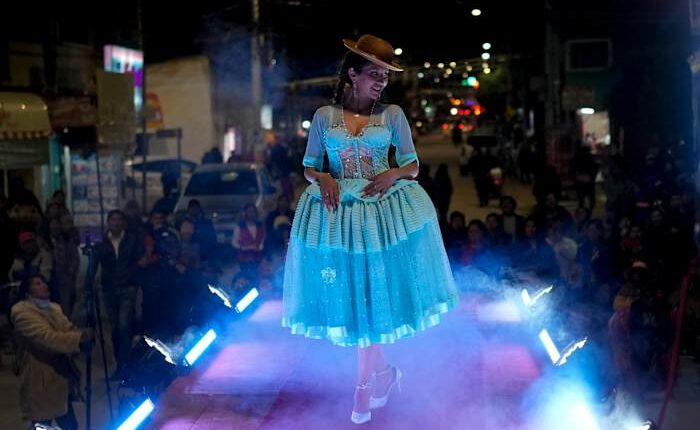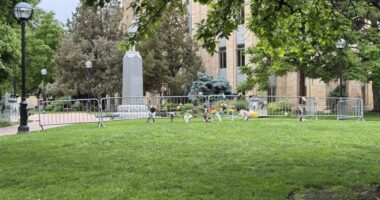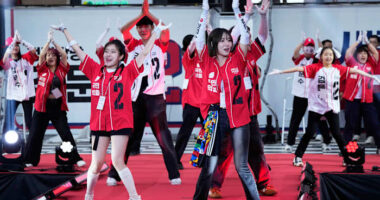
VIACHA – Viacha, a town southeast of Bolivia’s capital, is known for its markets, farms, and lively parties where women usually wear bowler hats, tiered skirts, and fringed shawls.
What’s less typical is for the fashion spotlight to turn to these outfits — worn by “Cholas,” Indigenous women from the highland Altiplano.
On a recent Friday night in Viacha, located about 22 kilometers from La Paz and sitting over 12,000 feet above sea level, teenage boys and mothers gathered in the main square to witness a unique event. The town’s dusty road was temporarily turned into a runway for a special fashion show.
The fashion show featured girls from Viacha, primarily students aged between 15 and 25. They confidently walked down the improvised catwalk while upbeat American pop music from the early 2000s played in the background. Street vendors sold hot dogs and empanadas, and the audience, comprised of supporters who cheered in both Spanish and the local Indigenous Aymaran language, filled the square.
Wearing glittering shoes and brightly colored, bunched-out skirts called “polleras,” the amateur models of all heights and sizes twirled, tipped their hats and threw sultry glances at the crowd.
“Years ago, people would associate these skirts with the fields, they’d look down on us as rural peasants,” said Rogelia Canaviri, 42, who couldn’t stop smiling as she watched her daughter, Carolina, stride down the runway in dangling pearl earrings, the sequins on her layer-cake red skirt catching the stage lights.
“It’s something I’m proud of, to see my daughter and her friends enjoy what I’ve worn for work my whole life,” she said, pointing to the wool shawl, velvet hat and lower-key beige pollera she had on — the same clothes, she said, she still wears to milk her cows and sell her cheese at open-air markets. Her own mother did the same.
Generations ago, the Aymara were subject to waves of conquest and dispossession, first by the Inca, then by the Spanish, who forced the Indigenous communities to abandon their traditional way of dressing and adopt the style then-popular in the court of Seville.
Legend has it that the jaunty felt bowler hat became critical to the get-up after being introduced by British railway workers in the 1920s.
Bolivia’s whiter, more affluent population has used “Chola” — and its diminutive, “Cholita” — as dismissive racial epithets. But in recent decades that stigma has dissipated, with Indigenous Aymara proudly reclaiming the word and younger Bolivians rediscovering the charm of their mothers’ and grandmothers’ vibrant garments.
“I think the ‘Cholita’ has become something very interesting, very exciting in our current context,” said Brittany Cantuta Valeria, 21, a first-time model, her hat brimmed upward and cheeks flushed a reddish gold.
“We’re now at the point of being respected because of everything that’s been implemented, so I wear this to have fun, to show off, to go to parties and dances. I have nothing to do with working the fields.”
Most of the girls parading onstage Friday, in the show organized by the Viacha municipality, grew up during the tenure of former leftist President Evo Morales (2006-2019), the country’s first-ever Indigenous president whose championing of Bolivia’s Indigenous majority earned him fervent support across the cinderblock and adobe homes of the Altiplano.
Morales instituted a new constitution, which, among other things, expanded recognition for Bolivia’s 36 ethnic groups. He promoted the teaching of Indigenous languages and boosted state funding for folkloric arts. More Chola runway shows and beauty contests cropped up, widening the reach of Bolivia’s native highland culture.
But fashion fanfare was largely limited to La Paz, the seat of the government. Before Friday, the town of Viacha, like most of the other villages across these austere mountain-rimmed plains, had never taken its turn on the runway.
“I was really nervous but I realized this is the first time for all of us,” said 15-year-old Tomasa Ramirez. “I feel so pretty. Now I know it’s my dream to be a Cholita model.”
With Bolivia’s economic crisis closing like a vise on families whose money has diminished in value while the cost of food has doubled, many girls said walking the show was no easy feat.
Top-notch velvet hats and shawls made from vicuña wool with silk fringes can fetch thousands of dollars. Polleras cost a few hundred dollars. Then there’s the jewelry — ideally made of real gold, pearls and diamonds when worn to these kinds of formal events.
“This year there was no way I could have real ones,” said Julieta Mamani, 16, pointing to her gold-colored earrings. “I hope things will be different next year.”
Watching her 24-year-old daughter pose for selfies in her elaborate skirt, Canaviri, the dairy farmer, has another hope.
“I hope she doesn’t like wearing pants,” she said of her daughter. “I tried on pants once in my life, and I felt naked. Never again.”
Copyright 2024 The Associated Press. All rights reserved. This material may not be published, broadcast, rewritten or redistributed without permission.















